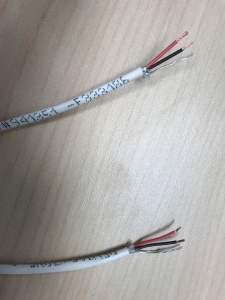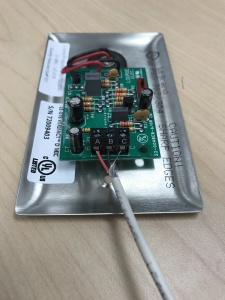Installing an Axis P3374/P3375 with a Louroe Verifact D Microphone
Required Parts And Tools
- Axis P3374 or P3375
- 3.5mm (Male to Male) Audio Cable
- Louroe Verifact D Microphone
- S2 TT20 Torx security bit
- Wire Stripper
- Wall Dog Screw Anchor
- Toggle Bolts (If mounting to drop ceiling tile)
- Drill bit and drill
- Phillips head drill bit or Phillips head screwdriver
- Small Flat head screwdriver
- Cat5/6 Patch Cable (7ft-15ft recommended)
- Shielded Stranded 22/2 + ground Wire
- 1 Mud ring if mounting to drywall, Datacom box if mounting to hard surface (ex. Cinderblock)
- Drywall Saw
Installation Instructions
- Locate the network drop above the ceiling either being a male Ethernet end (service loop) or a biscuit jack. This will have been ran back to the POE switch. If the switch does not have POE, a POE injector will need to be installed at the network closet.
- Mount your Axis P3374 or P3375 to either the wall below (using anchors and screws), or the drop ceiling tile (using the toggle bolts). For a wall mount, remove the P3374/P3375 camera from its base with the T20 security bit. Using a stud finder, ensure there aren’t any studs any behind the camera base. Using a pencil, trace the 2 anchor points on the wall where the screws will be installed and mark the opening where the any cabling would pass through.
- Using a 3/16” drill bit, drill 2 holes at the traced location and insert the plastic anchors. Using the hole saw (recommended size 2”), drill a hole into the area where cables will pass through. Ensure the cut hole does not extend past what the camera dome will cover
- Above the drop ceiling, locate the designated network drop. If the drop is terminated to a female connector or surface mount biscuit jack, you will need a patch cable. If there is an existing RJ-45 at the end of the drop, the patch cable won’t be needed. Using the hole saw, drill a hole above the drop ceiling in line with the hole drilled where the camera will be mounted. If there is no drywall above the ceiling, adjust accordingly to your circumstance.
- Mount the Axis P3374/3375 base to the wall using the screws associated with the anchors.
- Measure and cut 2 lengths of 22/2 wire long enough to reach the destination where the camera will be mounted. One cable will be for audio; the other will be to power the Verifact D. Label both ends of each wire accordingly. Using your glow rod or fish tape, fish the network drop and 2 sections of 22/2 audio cable down the drywall.
- Strip the jacket off the 22/2, revealing the red, black, and common (bare wire) on both sides of the cable. Remove the string and plastic casings covering the red and black cables. Strip the red and black jackets off the wire exposing the copper. Cut copper evenly on both ends (See picture)
- Cut a hole into the drywall, large enough to fit the mud ring into it securely. Feed one end of the the 22/2 audio cable through the hole. (If mounting on a hard surface, attached Datacom box to the wall). Connect the audio cable to the Verifact-D phoenix terminal as follows;; Red to A, Black to B, Common (bare wire) to C (See Picture)
- Connect the power cable to the IO phoenix connector (Red to 2, Black to 1).
- Place the dome over on the camera. Using the T20 bit, tighten the dome cover in place.
- Align Verifact-D with mud ring or Datacom box and screw in securely.

